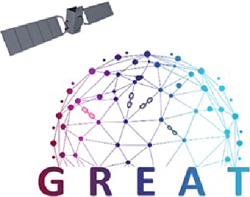Overview
Currently, GNSS reference networks are costly infrastructures that need specialized equipment and high costs for installation and maintenance. For this reason, most of the public and private GNSS networks are not very dense in the European territory and much less Worldwide.
At the same time, a large number of new applications, highly demanding in terms of positioning accuracy, would need to receive real-time differential corrections from reference stations that are 15 km or less far away. In this context, the density of the GNSS networks could become a key factor for the development of innovative services, ranging from mass market (e.g. for high precision positioning/navigation on new generation smartphones where raw GNSS measurements are available) to more specialized application domains (e.g. for GNSS-based real-time structural and geophysical monitoring). Moreover, some new safe sensitive applications such as autonomous driving and drones’ navigation will need reliable networks of reference stations that shall be redundant and resilient not only to local spoofing and jamming attacks, but also in general to cyber-attacks and emergency situations (e.g. earthquakes or natural disasters).
It appears that in the very few last years some chipset manufactures started delivering multi-constellation multi-frequency GNSS chipsets, which are very cost effective (less than 100 Euro per piece) but with performance allowing millimetric to centimetric level accuracy respectively in static and RTK (therefore like the state-of-the art professional GNSS receivers).
The concomitance of the need for higher density GNSS networks and of the availability of new multi-constellation multi-frequency GNSS chipsets has created the opportunity for the GREAT project (next generation Gnss REference stATion). The purpose of the GREAT project is the development, test and demonstration of the next generation of low-cost GNSS reference stations, which guarantee performance comparable to the ones of current geodetic grade receivers but with costs (in terms of equipment, setup and maintenance) up to one order of magnitude lower than the present standards.
The final goal of the project aims at the realization of infrastructures that bring the advantages of differential GNSS processing (both real-time and post-processing), in terms of precision and accuracy ranging from sub-meter (DGNSS technique) up to millimetre level (static differential processing), to the widest community of end-users as possible.
[immagini (da cercare): localizzazione di precisione, guida autonoma, droni, rilievi in cantiere, agricoltura di precisione]
Outcomes
The purpose of the GREAT project is the development of a new generation of low-cost GNSS reference stations, which guarantee performance comparable to the ones of current geodetic grade stations but with costs (in terms of equipment, setup and maintenance) several times lower than the present standards. The core of the new station are the innovative low-cost multi-frequency GNSS chipsets that have been entering the market in the very last few years, which are able to generate raw measurements with characteristics like the one of the traditional geodetic-grade chipsets.
Such new chipsets will be exploited in the design and realization of brand new GNSS receivers, specifically tailored to implement all functionalities expected from a permanent GNSS station (e.g. possibility to generate multi-frequency, multi-constellation raw measurements in real-time, to broadcast such data to the users through standard protocols like RTCM, to guarantee authentication of the measures, etc.).
With respect to the current state of the art, the new devices will be characterized by a dramatic reduction in power supply requirements, thus allowing their setup even in remote areas where the electricity grid is not available.
Moreover, the GREAT reference stations will implement the following set of peculiar and innovative differentiators:
- They will be fully autonomous and infrastructure-less solutions (no need for wired power or wired communication);
- They will implement OS-NMA anti-spoofing features;
- They will generate blockchain-based secure and traceable data flow;
- They will exploit IMU hybridization for the detection of abnormal movements, monitoring of vibration and to further improve the anti-spoofing capabilities.
The device to be developed will be completed by a suite of software tools enabling the remote control of the instrument and a real-time check of the quality, integrity and authenticity of the measures.
The outcome of the project is intended to be a system which can be exploited in different kinds of markets:
- In areas where CORS networks are already available (e.g. owned and maintained by International, National or Regional authorities) the new stations can be used to create denser local scale networks (to limit the maximum distance between stations to 20-30 Km) with relatively low budget.
- In areas where no CORS networks are already available (e.g. in developing countries or in regions where the number of potential users does not make it convenient to install costly and difficult to setup instrumentation), the GREAT reference stations can be used to implement primary level networks.



